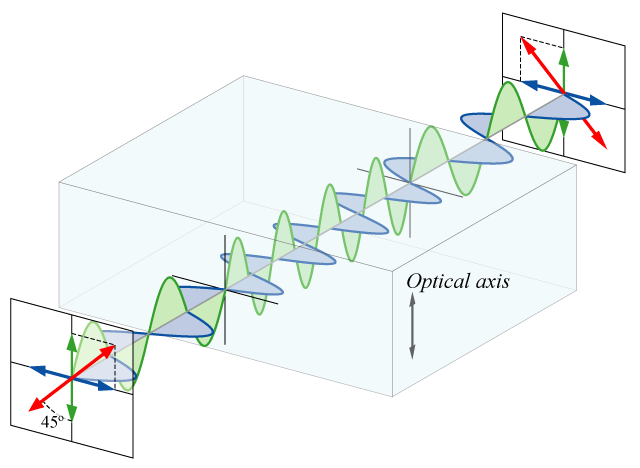A waveplate or retarder is an optical device that alters the polarization state of a light wave travelling through it. Two common types of waveplates are the half-wave plate, which shifts the polarization direction of linearly polarized light, and the quarter-wave plate, which converts linearly polarized light into circularly polarized light and vice versa. Waveplates are constructed out of a birefringent material (such as quartz or mica, or even plastic), for which the index of refraction is different for light linearly polarized along one or the other of two certain perpendicular crystal axes. The behavior of a waveplate (that is, whether it is a half-wave plate, a quarter-wave plate, etc.) depends on the thickness of the crystal, the wavelength of light, and the variation of the index of refraction. Naturally birefringent materials used for waveplates have lower damage thresholds than other optical materials and have absorption limiting their usefulness in high power, short wavelength laser operations.
This novel method of producing waveplates from isotropic optical materials (e.g. fused silica) consists of forming a void-dash metasurface using the following process steps:
- Deposition of a thin metal layer (e.g. gold or platinum) and dewetting to form nano-particle mask.
- Directional etching (e.g., reactive ion etching (RIE), reactive ion beam etching (RIBE)) normal to the surface to transfer the mask nanoparticle pattern into the substrate material.
- Deposition of a second metal mask layer at an angle producing linear dash shaped mask-free regions in the shadow of the rods formed in the previous process step
- Directional etching (e.g., RIE, RIBE) normal to the surface to generate void-dash structures in the mask-free regions left exposed by the previous step.
These process conditions can be tailored to achieve the desired optical properties.
Related LLNL technologies available for licensing
- Thin planar optical components generated with substrate-engraved metasurfaces
- Birefringent Waveplate and Method for Forming a Waveplate Having a Birefringent Metasurface
- Method of producing optical element with thicker substrate engraved metasurface layer
- Low-temperature fabrication method of bulk metamaterial structures for heat sensitive materials technology
- Scalable Method of Forming Birefringent Optical Metasurfaces Operating at Very Short Wavelengths
LLNL’s novel method for forming waveplates from common, durable, isotropic optical materials has numerous advantages over waveplates traditionally fabricated from naturally birefringent materials, such as:
- Better suited to higher average power laser applications.
- Not limited to the small aperture sizes only available with naturally birefringent materials.
- Ultra-thin, mechanically robust and environmentally stable waveplate optics.
- Can be used at shorter operating wavelengths, including ultraviolet.
- Polarization manipulation of large aperture, intense, high power laser beams.
- Controlling the transmission of intense, high power laser beams without introducing absorption.
- Converting intense, high power, linearly-polarized laser beams to circular polarization for advantageous light-matter interaction.
Current stage of technology development: TRL 2 (January 2023)
LLNL has filed for patent protection on this invention.


